Lap/Shoulder belt
Height adjustment (For Front seat)
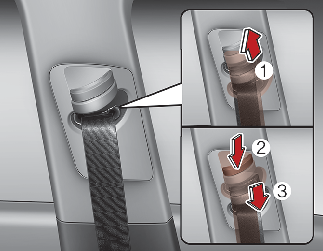
You can adjust the height of the shoulder belt anchor to one of 4 positions for maximum comfort and safety. The height of the adjusting seat belt should not be too close to your neck. You will not be getting the most effective protection. The shoulder portion should be adjusted so that it lies across your chest and midway over your shoulder near the door and not your neck.
To adjust the height of the seat belt anchor, lower or raise the height adjuster into an appropriate position.
To raise the height adjuster, pull it up (1). To lower it, push it down (3) while pressing the height adjuster button (2).
Release the button to lock the anchor into position. Try sliding the height adjuster to make sure that it has locked into position.
Improperly positioned seat belts can cause serious injuries in an accident.

-
Verify the shoulder belt anchor is locked into position at the appropriate height. Never position the shoulder belt across your neck or face.
-
Failure to replace seat belts after an accident could leave you with damaged seat belts that will not provide protection in the event of another collision leading to personal injury or death. Replace your seat belts after being in an accident as soon as possible.
To fasten your seat belt:
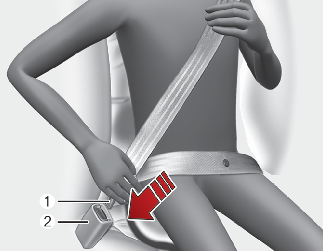
To fasten your seat belt, pull it out of the retractor and insert the metal tab (1) into the buckle (2). There will be an audible "click" when the tab locks into the buckle.
The seat belt automatically adjusts to the proper length only after the lap belt portion is adjusted manually so that it fits snugly around your hips. If you lean forward in a slow, easy motion, the belt will extend and let you move around. If there is a sudden stop or impact, however, the belt will lock into position. It will also lock if you try to lean forward too quickly.

If you are not able to pull out the seat belt from the retractor, firmly pull the belt out and release it. Then you will be able to pull the belt out smoothly.
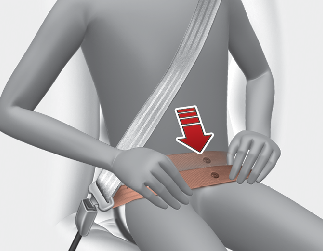

You should place the lap belt portion as low as possible and snugly across your hips, not on your waist. If the lap belt is located too high on your waist, it may increase the chance of injury in the event of a collision. Both arms should not be under or over the belt. Rather, one should be over and the other under, as shown in the illustration.
Never wear the seat belt under the arm near the door.
To release the seat belt:
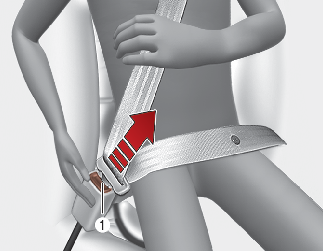
The seat belt is released by pressing the release button (1) in the locking buckle. When it is released, the belt should automatically draw back into the retractor.
If this does not happen, check the belt to be sure it is not twisted, then try again.
Stowing the rear seat belt
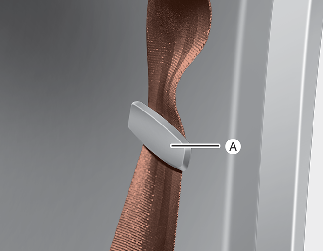
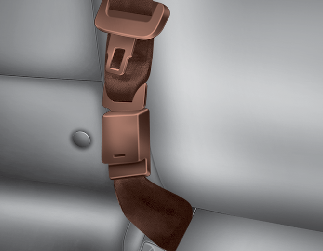
-
If the center seat belt is not in use, always lock the latch plate into the buckle as above illustration.
-
The rear seat belt buckles can be stowed in the pocket between the rear seatback and cushion when not in use.
-
Then insert the seat belt into the two webbing guide (or holder)(A) located on both sides. It will help keep the belts from being trapped behind or under the seats.
After inserting the seat belt, tighten the belt webbing by pulling it up.
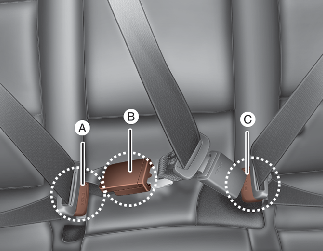
The seat belt should be locked into the buckle on each seat cushion to be properly fastened.
* A : Rear right seat belt fastening buckle
* B : Rear center seat belt fastening buckle
* C : Rear left seat belt fastening buckle
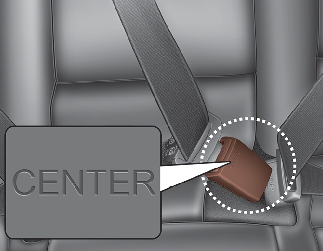
When using the rear center seat belt, the buckle with the “CENTER” mark must be used.

Do not force to lock the left or right seat belt into the center seat belt buckle.
Make sure to lock the rear center seat belt into the center seat belt buckle.
If not, the improperly fastened seat belt will not be able to provide protection.